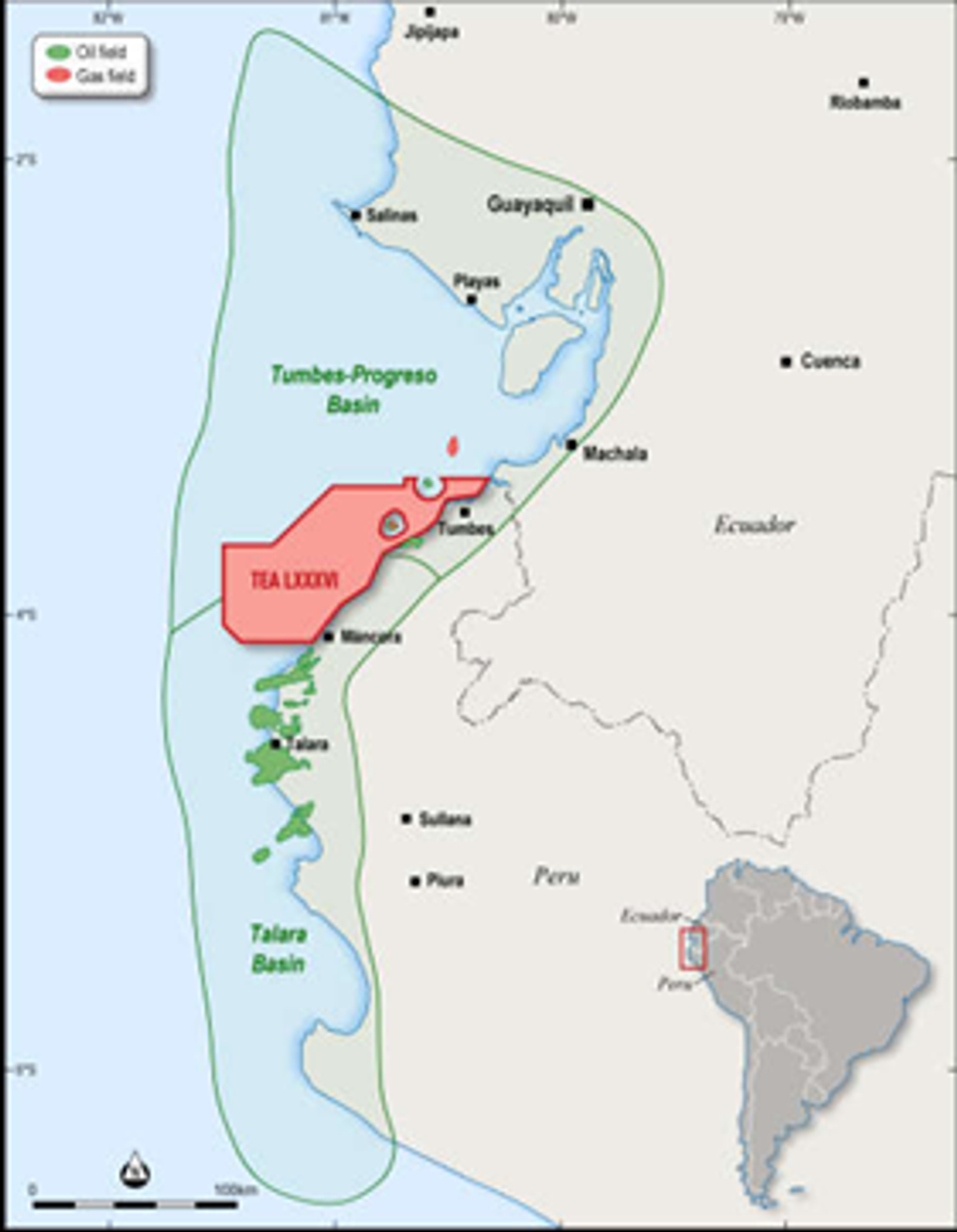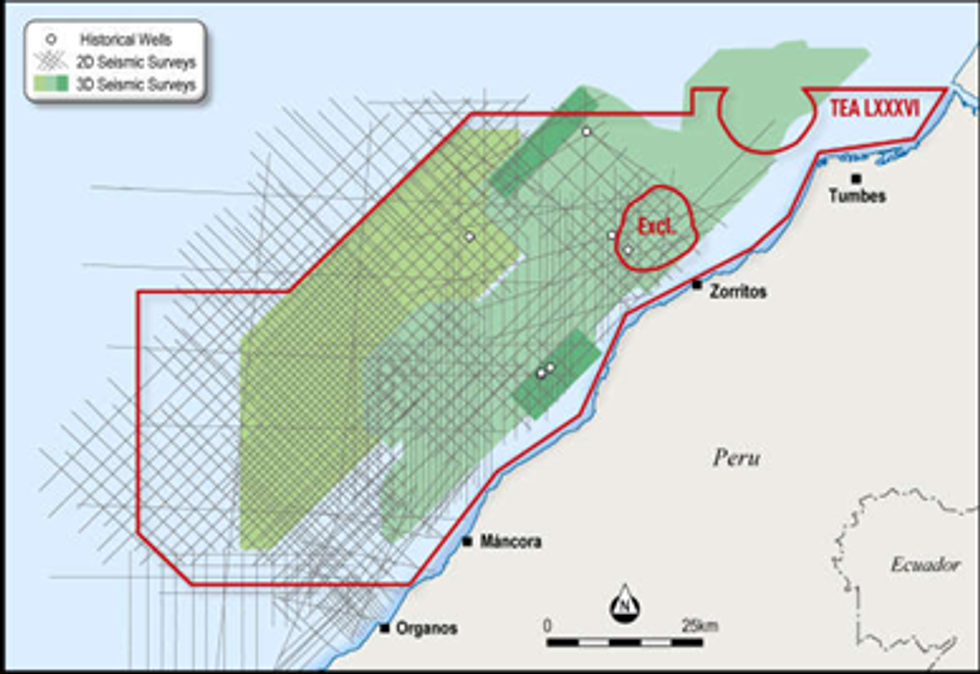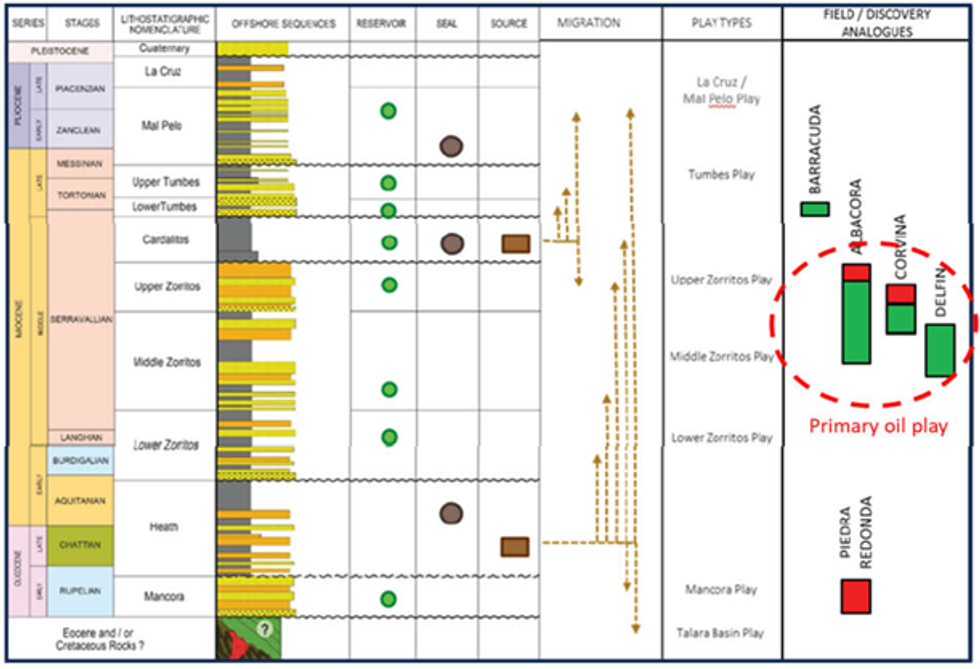
January 22, 2024
Global Oil & Gas Limited (ASX: GLV) (Global or Company) is pleased to provide an update on its Tumbes Basin Technical Evaluation Agreement (“TEA”) offshore Peru (Figure 1). In August 2023, the Company executed TEA LXXXVI with PeruPetro, the Government department responsible for the administration and promotion of oil and gas exploration in Peru. The 4,858km2 TEA incorporates almost all of the offshore Tumbes Basin, in moderate water depths of between 100m and 1,500m. The block is surrounded by, and includes, multiple historic and currently producing oil and gas fields.
Highlights
- Identification and interpretation of historical data has identified more than 20 potential leads in the TEA area.
- Work programme commenced to develop, rank and ‘high-grade’ these leads and define new prospective features.
- The next milestone will be to select areas for 3D seismic reprocessing with a view to the deployment of new Quantitative Interpretation and Artificial Intelligence based interpretation methodologies.

The Company has now collected and curated a significant quantity of geophysical and geological data over the TEA and the wider Tumbes Basin and interpretation work is underway.

There are several oil and gas discoveries in the Tumbes Basin itself, with the southerly adjacent Talara Basin representing the most prolific offshore hydrocarbon basin in Peru. The majority of existing discoveries and prospective targets in the Tumbes Basin are within the Miocene Zorritos Formation, with hydrocarbons sourced from the Oligo-Miocene Heath Formation (Figure 3).

The Tumbes Basin has a complex geological history related to the Pacific Plate colliding with, and being subducted beneath, the South American Plate. The basin is heavily faulted (Figure 4) creating a multitude of structural trapping styles.
Despite the presence of several discoveries within and adjacent to the TEA area, only one well, Marina- 1, has been drilled to test an exploration prospect informed by 3D seismic data. Marina-1 was drilled in 2020 and encountered some hydrocarbon shows in shallow Pliocene reservoirs, however the anticipated reservoirs in the Tumbes Formation were not well developed. The well did not reach the Zorritos Formation which is the primary reservoir target in the basin.
Marina-1 was a commitment well drilled in the early period of the COVID pandemic when oil prices had dropped significantly due to global uncertainty.
The results of the Marina-1 are to be reviewed in detail and will be of value in determining where the Tumbes reservoir might be better developed. There are over 3,800 km2 of 3D seismic data within the TEA area and, as noted above, Marina-1 is the only exploration well to have been drilled since these data were acquired.
Click here for the full ASX Release
This article includes content from Global Oil & Gas Limited, licensed for the purpose of publishing on Investing News Australia. This article does not constitute financial product advice. It is your responsibility to perform proper due diligence before acting upon any information provided here. Please refer to our full disclaimer here.
GLV:AU
The Conversation (0)
05 January
US Intervention in Venezuela Stirs Oil Market Uncertainty
Oil prices moved uneasily at the start of the week as market participants digested the implications of a sudden US intervention in Venezuela over the weekend. Brent crude slipped as much as 1.2 percent in early trading on Monday (January 5), falling to around US$60 per barrel before recovering... Keep Reading...
05 January
Angkor Resources Signs Definitive Agreement to Sell Evesham Oil Production
(TheNewswire) GRANDE PRAIRIE, ALBERTA TheNewswire - January 5, 2026 - Angkor Resources Corp. (TSXV: ANK,OTC:ANKOF) ("ANGKOR" OR "THE COMPANY") is pleased to announce that it has completed the Definitive Agreement ("Agreement") with an arm's length party (the "Purchaser") to sell its 40%... Keep Reading...
01 January
Josef Schachter: Oil Stock Buy Signal Approaching, 3 Triggers to Watch
Josef Schachter, president and author at the Schachter Energy Report, shares his thoughts on oil and natural gas prices, supply and demand in 2026. "I think before the cycle is over, the 2007 high of US$147 (per barrel) will be breached, because the industry cannot respond quickly by bringing on... Keep Reading...
24 December 2025
5 Best-performing Canadian Oil and Gas Stocks
The oil and gas sector closed 2025 amid sharp swings, as ample supply and uneven demand weighed on prices.Crude benchmarks trended lower through the year, with rising output from non-OPEC producers, led by record US production, and higher OPEC+ quotas creating a persistent supply overhang.After... Keep Reading...
22 December 2025
5 Biggest ASX Oil and Gas Stocks
Oil and gas are key energy fuels, and ASX-listed oil and gas stocks could benefit from their price moves. For the most part, 2025 was a volatile year for both the oil and gas markets. In the first half of the year, oil prices posted moderate gains, spurred on by rising tensions in the Middle... Keep Reading...
22 December 2025
CHARBONE Delivers its First Load of Clean UHP Hydrogen in Ontario
- Charbone CORPORATION (TSXV: CH,OTC:CHHYF; OTCQB: CHHYF; FSE: K47) ("Charbone" or the "Company"), a North American producer and distributor specializing in clean Ultra High Purity ("UHP") hydrogen and strategic industrial gases, is pleased to announce the successful delivery of the first load... Keep Reading...
Latest News
Interactive Chart
Latest Press Releases
Related News
TOP STOCKS
American Battery4.030.24
Aion Therapeutic0.10-0.01
Cybin Corp2.140.00





